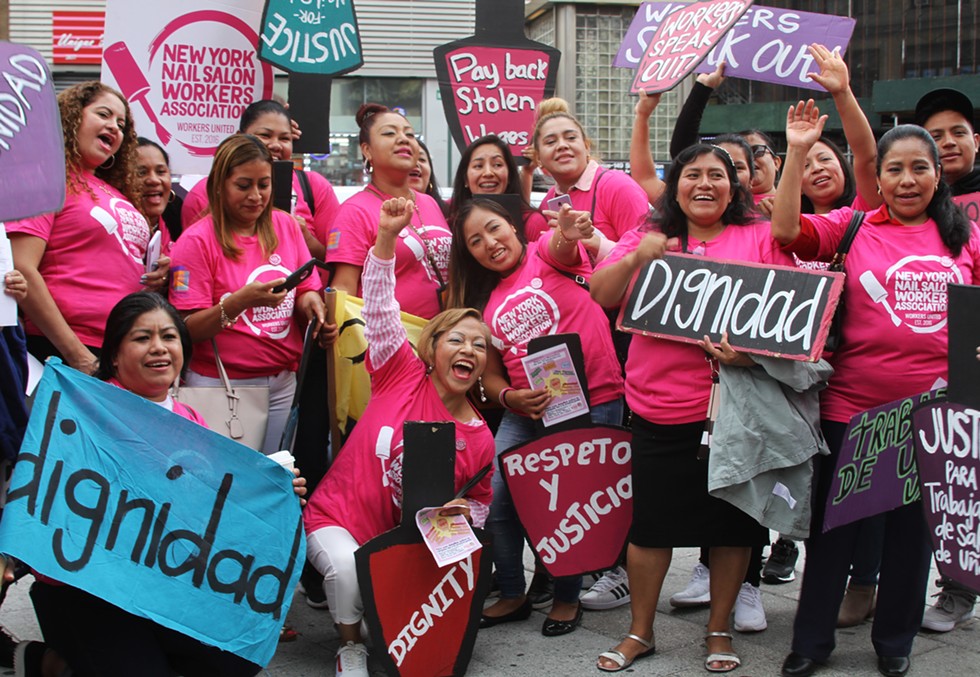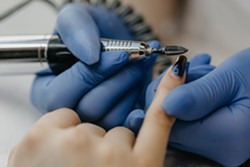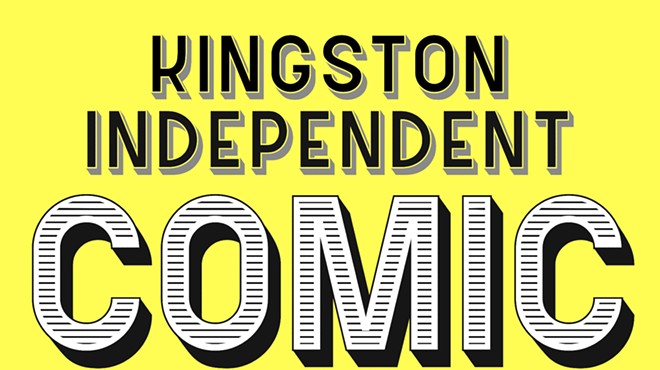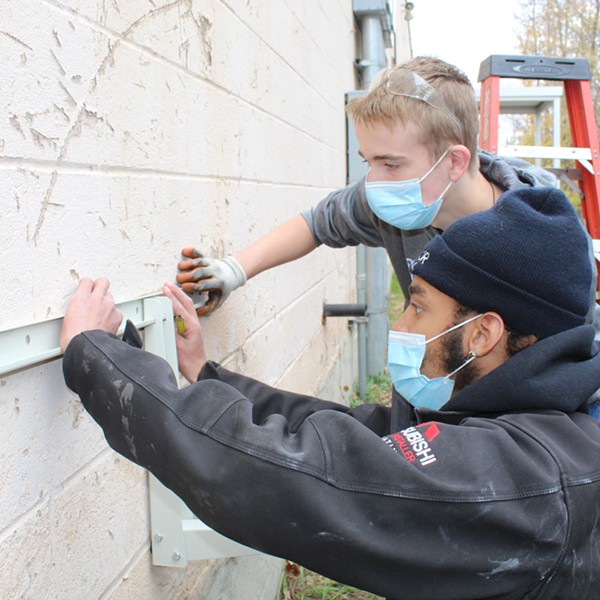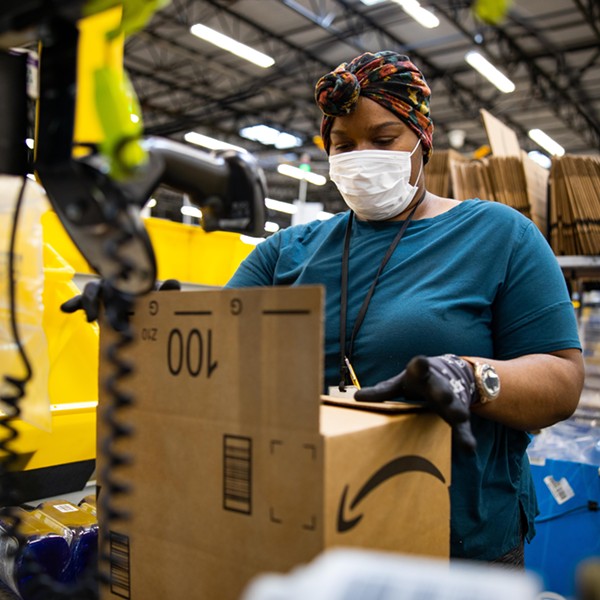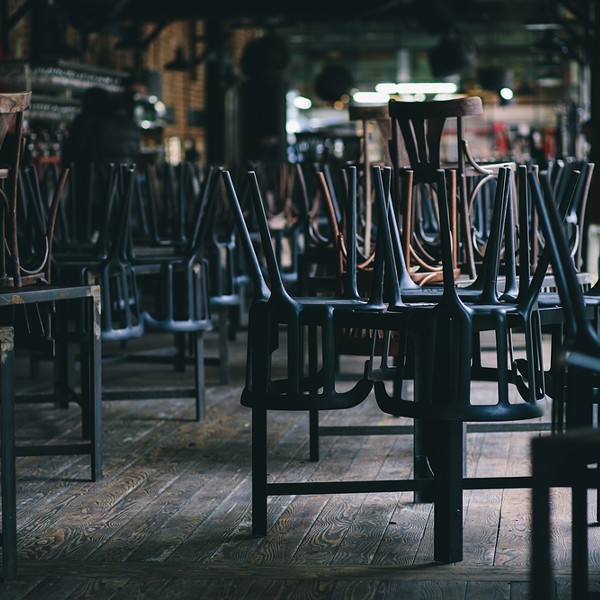When her boss told her it was finally time for her lunch break, Maritza Ovalles jumped out of her chair at the Bronx nail salon she worked at. Breaks were hard to come by during her 9am to 8pm shifts. It was 2019, but Ovalles says not getting a break was common during her 15 years working in salons across four boroughs.
On this day, Ovalles was grateful to get lunch. She put her food in the microwave, setting the timer between two and three minutes. But as soon as it beeped, her boss called to her: “Customer is here! Break is over!”
This anecdote is just one example of a culture Ovalles describes at the nail salons she’s worked at, where “respecting our time has always been an issue.” Six days a week, Ovalles worked 11 hours a day, totaling a 66-hour work week, at the end of which she’d collect $130 from her employer—an average of $1.97 an hour.
And that was before the pandemic. Since the COVID-19 lockdowns began last March, conditions for salon employees across the industry have greatly worsened. Most of the workers—who are largely Asian and Latina immigrant women—became unemployed. But unlike other wage workers who temporarily benefited from unemployment insurance and stimulus checks, 81 percent of salon employees were unable to qualify for government assistance due to their legal status, according to an April 2021 report entitled “One Fair Wage Denied” from the New York Nail Salon Workers Association, an organization of more than 800 salon workers fighting to improve working conditions in the industry. What’s more, 29 percent of salon workers in New York City, the epicenter of the industry, are known to have contracted COVID-19—almost three times as high as the overall city rate.
Advocates for nail salon workers say the glaring health and financial tragedies they faced during the pandemic are not random, but rather the legacy of an industry that has always been toxic, figuratively and literally, to those it employs: a demographic who historically have been subjected to poor working conditions and wage theft.
Nail salon workers like Ovalles acknowledge that their jobs would be more enjoyable if workers were guaranteed rights such as breaks, fair wages, and proper ventilation, among other changes. Advocates have been working to create these changes so that as salons reopen with the rest of businesses across America, they reopen improved.
No Such Thing As Cheap Luxury
In 2015, a New York Times investigation into conditions at nail salons revealed an uglier truth to an industry whose reputation had once been quite polished. Details included dark vans in the early hours that carried women to work, where they were forced to pay $100 for the “opportunity” to work for free until they were deemed deserving of payment; women who were threatened with police calls and deportation when they asked to take a lunch break; and wages so meager that an entire day’s labor could amount to a $30 paycheck.
Since then, there’s been a spike in awareness and action for three primary issues nail salon workers have faced even before the pandemic: toxic fumes and poor ventilation, rampant wage theft, and the denial of deserved employee benefits such as social security and paid sick leave.
In the wake of COVID-19, the most timely issue is the health environment that nail salon workers are working in. Some of the chemicals used in salons cause dizziness, headaches, and nausea, side effects exacerbated by a lack of ventilation and personal protection equipment. Long term, the chemicals have been linked to asthma, respiratory issues, cancers, harm to unborn children, and liver and kidney damage.
In a 2015 study done by Adhikaar, a Nepali immigrant-focused organization that has been organizing nail salon workers since 2005, more than half of workers said they began experiencing health problems after starting work at a nail salon, with 37 percent enduring eye irritation and 33 percent reporting headaches. Ovalles says that in the salons she worked in, the only form of ventilation was leaving the door open. She describes experiencing intense headaches.
If they do get sick, salon workers have little recourse. Salon workers are often misclassified as independent contractors instead of employees, which means they don’t get benefits such as paid time off, social security, workers compensation, minimum wage, and health and safety protections.
Instead, they are promised a deal: if they work a certain amount of hours in potentially unsafe conditions, they will be compensated with a specific amount of money. But each week nail salon workers end up getting paid an average of $174 less than the already subminimum wages they’ve been promised, according to the “One Fair Wage Denied” report, which showed wage theft in nail salons amounts to an average of over $9,000 in stolen wages a year.
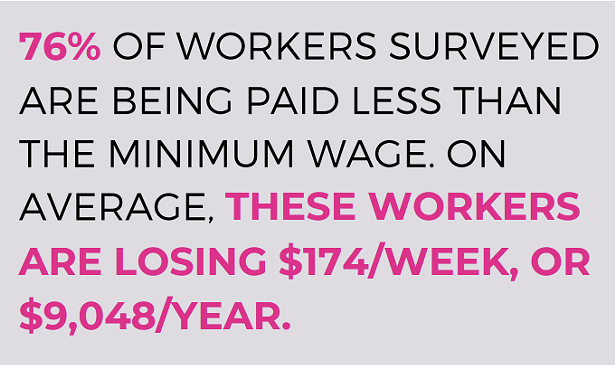
Several bills passed in the state legislature and in New York City in recent years bear on the issue of minimum wage and wage theft, but this past April, the New York Nail Salon Workers Association found that three-quarters of nail salon workers were still being paid less than minimum wage.
Progress Halted by Lack of Compliance
The New York Healthy Nail Salons Coalition is a collective of three organizations (Adhikaar, Workers United, and the New York Committee for Occupational Safety and Health) who joined forces in 2014 with a goal of making nail salons safe and rewarding places to work. The coalition has played a key role in getting legislation passed to improve the industry.
Several key measures were passed at the state level in 2015 and 2016 to protect salon workers, including laws requiring a nail salon bill of rights to be posted in plain view in the appropriate languages in every salon, for N95 or N100 respirators to be provided to each nail artist free of cost to them, for appropriate ventilation throughout the salon, for wage bonds assuring business owners can pay their workers the correct wages, and for licensing exams and trainee licenses. This year, salon workers achieved another major win in the NY HERO Act, which is designed to protect workers from airborne infections. It requires the state Department of Labor to make health and safety models for salons accordingly.
But enforcement is lacking. “We’ve been able to advocate for really good laws, but what’s missing is compliance,” says Clara Wheatley-Schaller, political director of New York-New Jersey Workers United, the union representation for the Salon Workers Association. “We’ve been trying to come up with creative ways to incentivize compliance…but there’s a race to the bottom in the industry that incentivizes owners not to comply. If the salon down the street isn’t paying minimum wage, how are you going to be able to pay minimum wage and follow health and safety laws and stay in business?”
And according to Hayley Gorenberg, legal director of New York Lawyers for the Public Interest, “there are many reports of still-recent workplace abuse, failure to provide adequate protective gear, inadequate wages, illegal wages, or wage theft.”
In short, the legislation that has been passed hasn’t adequately addressed the issues it’s meant to. And due to the impacts of the COVID-19 pandemic, the active practice of these laws is more important now than ever. The side effects of some of the toxic chemicals used in polish, remover, and nail glue have been linked to weakening the respiratory system, a dangerous precursor to the spread of a virus that attacks the respiratory tract.
“Because COVID is an airborne disease, it makes the ventilation and job protection pieces so much more important,” says Prarthana Gurung, Adhikaar’s director of campaigns and communications.
“They always try to take advantage of us.”
For salon workers and their advocates, the fight continues. A newer piece of legislation, the Nail Salon Accountability Act, is meant to tighten enforcement. It has two parts. One pairs compliance with licensure, meaning that in order for a salon to get its license and to continue to renew it, the salon must prove it is in accordance with the law, including showing wage bonds and mandatory training for employees and owners on their health and safety rights as well as their wage rights. The second part requires training for both salon workers and owners about the laws that protect them and that they must abide by, respectively.
“In the current business licensing process, there are no good mechanisms to ensure employer compliance with labor and health and safety laws, which allows unscrupulous businesses to continue to break the law and puts the onus on workers to file complaints,” the bill states.
Originally introduced in the 2019-20 legislative session, the Nail Salon Accountability Act has not yet passed, but advocates are hopeful of its chances next year. Without it, some fear the past policy wins will be meaningless because they won’t be actively enforced.
Unfortunately they may be facing a paradox. The pandemic means workers need the laws to be enforced more than ever, but some believe the pandemic may also make officials more hesitant to crack down on small businesses.
As businesses emerge from the tangle of regulations and restrictions related to the pandemic, there has been an intensified desire to make it as easy as possible for them to reopen. Advocates fear some legislators worry that the Nail Salon Accountability Act will make it harder for small businesses. But the act doesn’t impose any new laws that should make it harder for business owners; it just reinforces pre-existing ones that would make working more fair for employees.
“If you’re saying, ‘this is really expensive for us,’ you’re basically saying, ‘because we’re not currently paying our workers minimum wage and following the health and safety regulations,’” Wheatley-Schaller says. “It’s not a huge extra cost.”
Salon advocates also joined calls for a fund that would provide assistance to workers who do not qualify for government assistance but suffered income loss because of the pandemic. In April, more than a year after the pandemic lockdowns began, New York State agreed to create a $2.1 billion Excluded Workers Fund, after “steadfast efforts by advocates and impacted communities across the state.”
But for Ovalles, though she loves the job she’s been doing for the past 15 years, she is starting to lose hope she’ll be able to keep working in it. Since she returned to the salon, she’s experienced headaches, dizziness, and joint pain from the job. The long hours with little to no breaks have continued.
“It doesn’t matter how the laws change,” Ovalles says, her voice filled with disappointment. “They always try to take advantage of us.”
How to Get an Ethical Manicure
For many flawed industries or systems, the consensus tends to be that ethical consumers who learn of the injustices should boycott that industry. But for issues in the nail salon industry, boycotting is an unhelpful solution, says Prarthana Gurung, the director of campaigns and communications at Adhikaar, an advocacy group leading the fight for equity in nail salons.
“Of course there’s a lot of issues with the industry, but we also want the industry to improve and be a place where our members, like the women in our community, really feel like they can go to build economic mobility in the future…so the more we can support it, financially and economically, the better.”
Here are some ways to make your experience at the nail salon more beneficial to the salon workers.
- Tip in cash, directly to your manicurist
- Tip as much as you can. “Obviously $15 minimum wage, even if they are receiving that, isn’t enough,” Gurung says. “It’s not a living wage.”
- Practice mask-wearing; respect mask-wearing
- Even after COVID-19 regulations are lifted, face masks should be a normal part of working in a salon—as they should’ve been before the pandemic—in order to protect employees and customers from toxic chemicals. “If workers want to wear masks, let them wear masks,” says Clara Wheatley-Schaller, political director at the New York-New Jersey Regional Joint Board of Workers United.
- Don’t avoid full price
- New York City boasts of having the cheapest manicures in the nation. Although you can’t assume how much workers are getting paid based on the cost of the manicure, research from Workers United’s 2020 “Race to the Bottom” report found that “as service prices increase, wage theft decreases.” The report states: “At salons where manicures are $15 or less, workers experience an average of $123 in wage theft per week. At salons where manicures are $16 and higher, workers are paid an average of $58 more than the required minimum wage.”
- Support organizing for better conditions
- Call your local representatives and advocate for the Nail Salon Accountability Act to be passed and continue raising awareness for it. “We definitely want consumers to continue supporting salons and going to salons but also join us in our advocacy to build a better industry,” says Wheatley-Schaller.
“Don’t avoid going to the salon just because you’re like, ‘Oh, I heard this is a horrible place,’” says Gurung. “It’s a mindset change about how you go in there, as opposed to something that you think is just a cheap manicure. Good practices will follow once you change your mindset about how you look at the industry and workers.”







